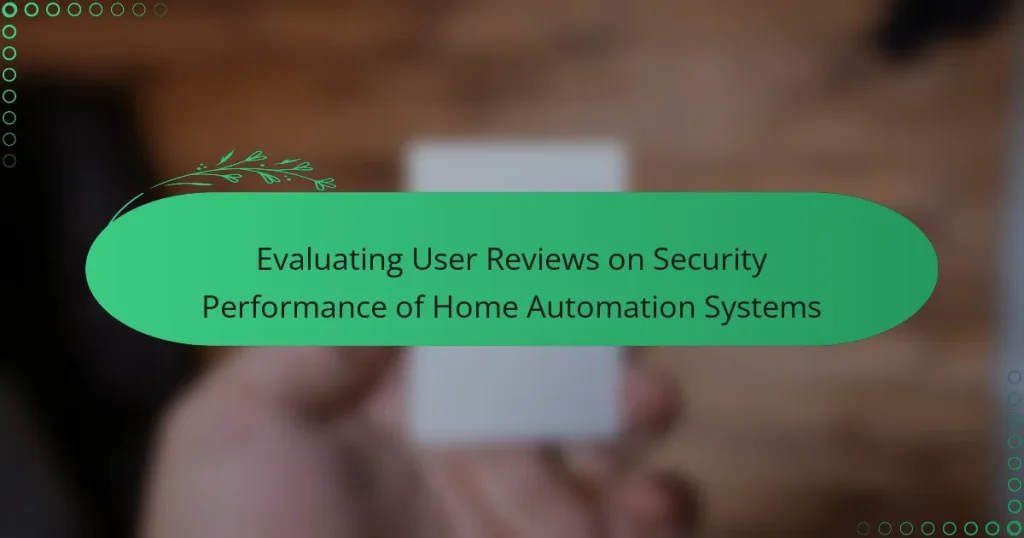Evaluating user reviews on home automation security systems is essential for understanding their effectiveness and reliability. By analyzing user experiences, identifying common concerns, and incorporating expert opinions, you can make informed decisions about the best systems available. These evaluations highlight the importance of features such as remote monitoring, real-time alerts, and integration with other smart devices in enhancing home safety.
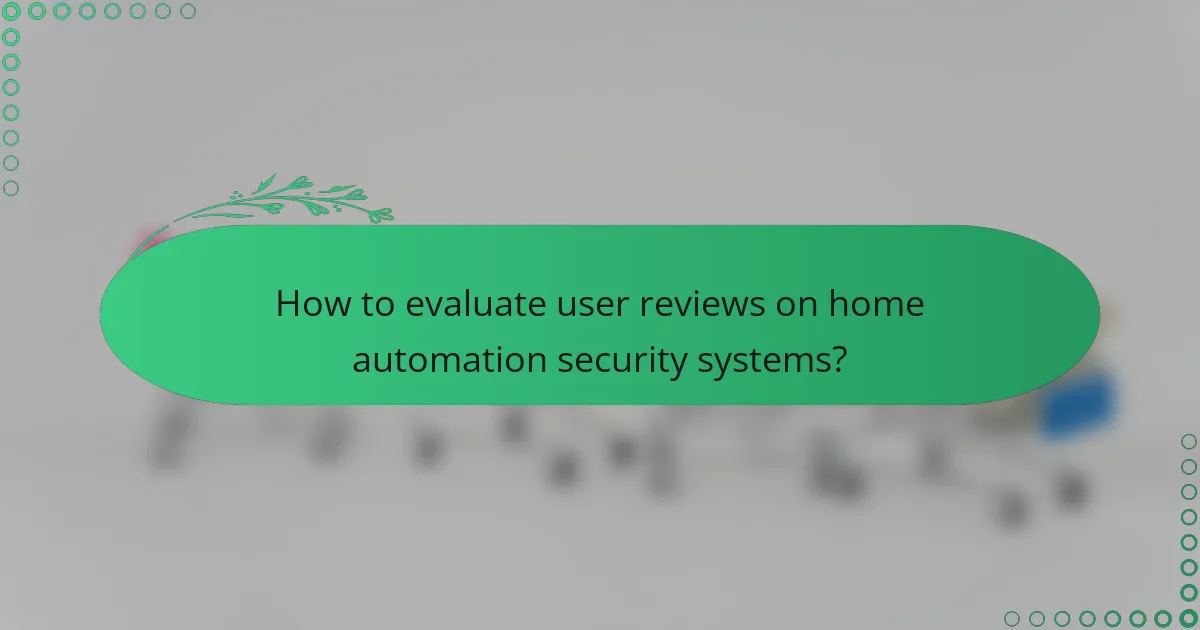
How to evaluate user reviews on home automation security systems?
Evaluating user reviews on home automation security systems involves examining the credibility of sources, identifying recurring issues, and considering expert insights. This process helps you gauge the reliability and effectiveness of different systems based on real user experiences.
Analyze review sources
Start by assessing where the reviews are coming from. Trusted platforms like Consumer Reports, CNET, or specialized tech forums often provide more reliable feedback than random blogs or social media posts. Look for reviews that include detailed descriptions of user experiences rather than vague comments.
Check the volume of reviews on a particular system. A higher number of reviews can indicate a more reliable consensus, while a few reviews may not provide a complete picture. Aim for systems with hundreds of reviews to ensure a broad range of feedback.
Identify common themes
As you read through reviews, take note of recurring themes or issues mentioned by multiple users. Common concerns might include ease of installation, reliability of alerts, or customer service responsiveness. Highlighting these themes can help you understand the strengths and weaknesses of a system.
Consider creating a simple chart to categorize these themes. For example, list features like “ease of use,” “security breaches,” or “app functionality” and mark how many reviews mention each aspect. This visual representation can clarify which issues are most significant.
Look for expert opinions
Expert reviews can provide valuable insights that user reviews may lack. Look for articles or videos from reputable tech reviewers who specialize in home automation systems. They often conduct in-depth analyses and can highlight features that users might overlook.
Pay attention to any certifications or standards mentioned by experts, such as compliance with security protocols. These endorsements can add credibility to the systems you are considering.
Check for recent updates
Technology evolves rapidly, and so do home automation systems. Ensure that the reviews you are reading are recent, as older reviews may not reflect current performance or features. Look for comments that mention updates or changes to the system.
Consider checking the manufacturer’s website for the latest information on firmware updates or improvements. This can give you an idea of how actively the company supports its products.
Assess user engagement
User engagement can indicate the reliability of reviews. Look for reviews that have responses from the manufacturer or follow-up comments from users. This interaction can show that the company is responsive to concerns and values customer feedback.
Additionally, consider the overall sentiment of the reviews. A system with a high number of positive reviews and engaged users is likely to be more trustworthy. Avoid systems that have a significant number of unresolved complaints or negative interactions.
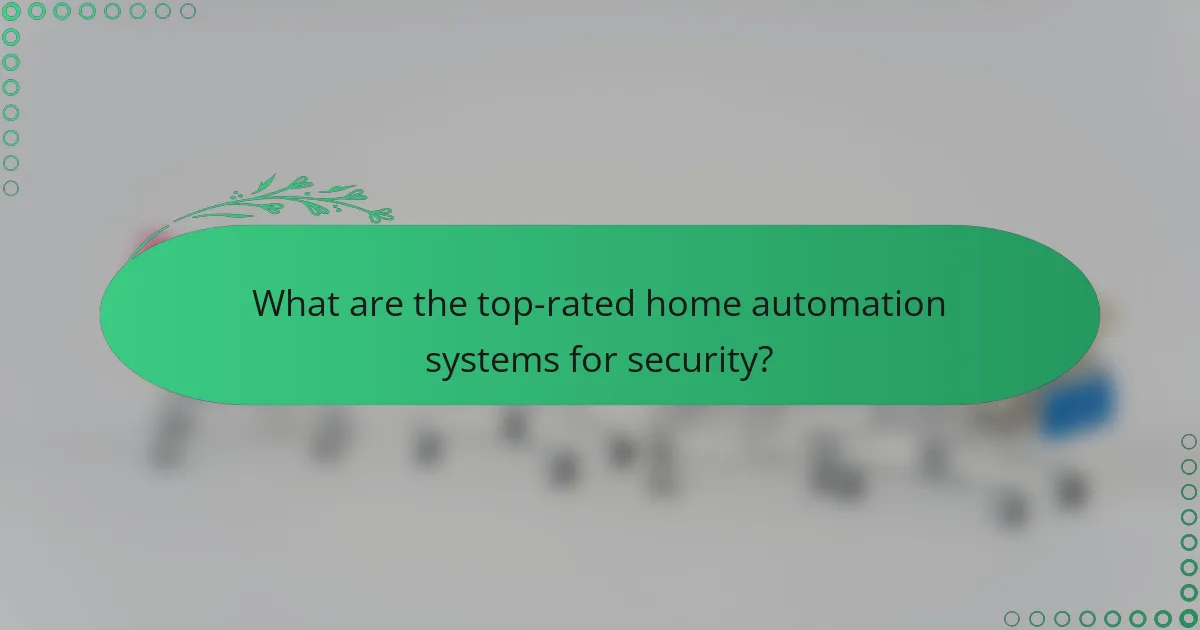
What are the top-rated home automation systems for security?
The top-rated home automation systems for security include solutions that combine smart technology with robust monitoring features. These systems not only enhance home safety but also offer user-friendly interfaces and integration with other smart devices.
Ring Alarm Security Kit
The Ring Alarm Security Kit is a comprehensive solution that includes a base station, keypad, contact sensors, and motion detectors. It is designed for easy installation and can be expanded with additional devices like cameras and smart lighting.
This system offers professional monitoring options starting at a reasonable monthly fee, making it accessible for many homeowners. Users appreciate its integration with the Ring app, allowing for remote monitoring and control.
Google Nest Secure
Google Nest Secure is a sleek, user-friendly security system that integrates seamlessly with other Google smart home products. It features motion sensors, door/window sensors, and a hub that connects everything through the Google Home app.
One of its standout features is the ability to use voice commands for system control, enhancing convenience. However, users should be aware that professional monitoring services are available but may come at a higher price compared to competitors.
Arlo Smart Home Security System
The Arlo Smart Home Security System is known for its high-definition cameras and advanced motion detection capabilities. It offers a range of camera options, including indoor and outdoor models, which can be monitored via the Arlo app.
Arlo’s subscription plans provide cloud storage for recorded footage, which is a key feature for users who want to review past events. While the initial setup can be straightforward, users should consider the costs associated with additional storage and features.
SimpliSafe Home Security System
SimpliSafe is a flexible home security system that allows users to customize their setup based on individual needs. It includes a variety of sensors and cameras, and installation is typically quick and straightforward.
SimpliSafe offers no-contract monitoring plans, which is appealing for those looking for flexibility. However, users should evaluate the range of equipment available to ensure it meets their specific security requirements.
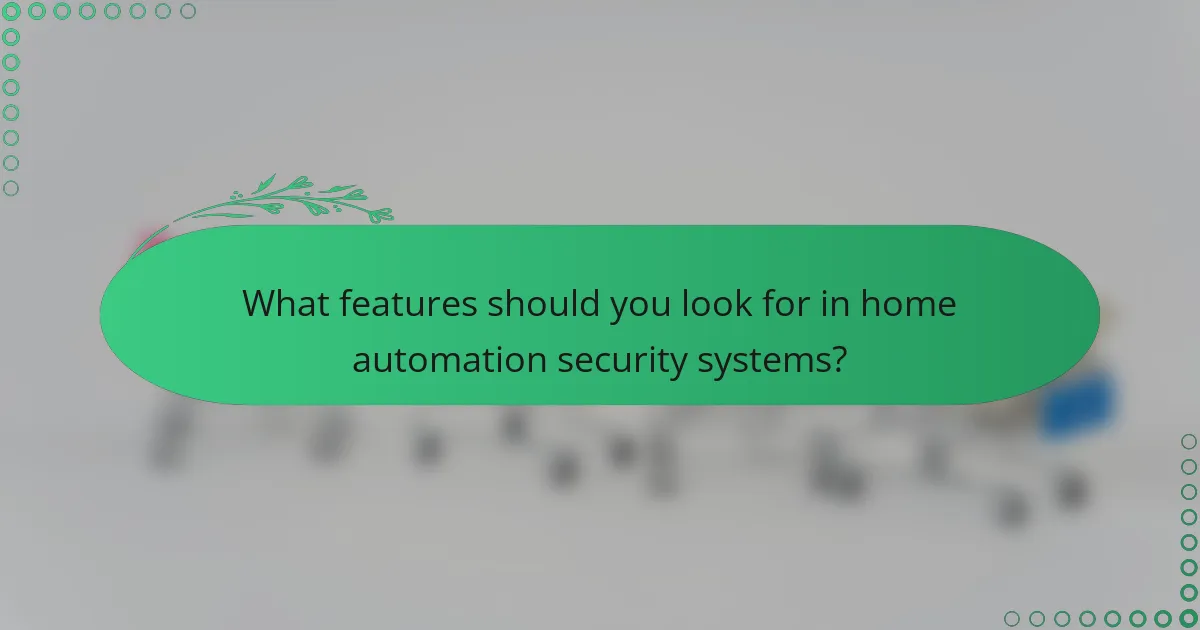
What features should you look for in home automation security systems?
When evaluating home automation security systems, focus on features that enhance safety, convenience, and integration. Key aspects include remote monitoring, smart device compatibility, real-time alerts, and video surveillance options.
Remote monitoring capabilities
Remote monitoring allows homeowners to keep an eye on their property from anywhere using a smartphone or computer. Look for systems that offer live feeds and recorded footage, enabling you to check in at any time.
Consider platforms that support multiple camera views and have user-friendly apps. This feature is crucial for peace of mind, especially when traveling or away from home for extended periods.
Integration with smart devices
Integration with smart devices enhances the functionality of home automation security systems. Ensure the system can connect with devices like smart locks, lights, and thermostats for a cohesive smart home experience.
Compatibility with popular ecosystems, such as Amazon Alexa or Google Assistant, can streamline operations and allow for voice control. This integration not only improves security but also adds convenience to daily routines.
Real-time alerts and notifications
Real-time alerts and notifications are essential for immediate awareness of security breaches. Look for systems that send instant alerts via push notifications, emails, or SMS when suspicious activity is detected.
Choose systems that allow customization of alert settings, so you can prioritize what matters most, such as motion detection or door sensor triggers. This feature helps you respond quickly to potential threats.
Video surveillance options
Video surveillance options are a critical component of any home automation security system. High-definition cameras with night vision and wide-angle lenses provide comprehensive coverage of your property.
Consider systems that offer cloud storage for recorded footage, allowing you to access past events easily. Some systems also provide features like two-way audio, enabling communication through the camera, which can deter intruders.
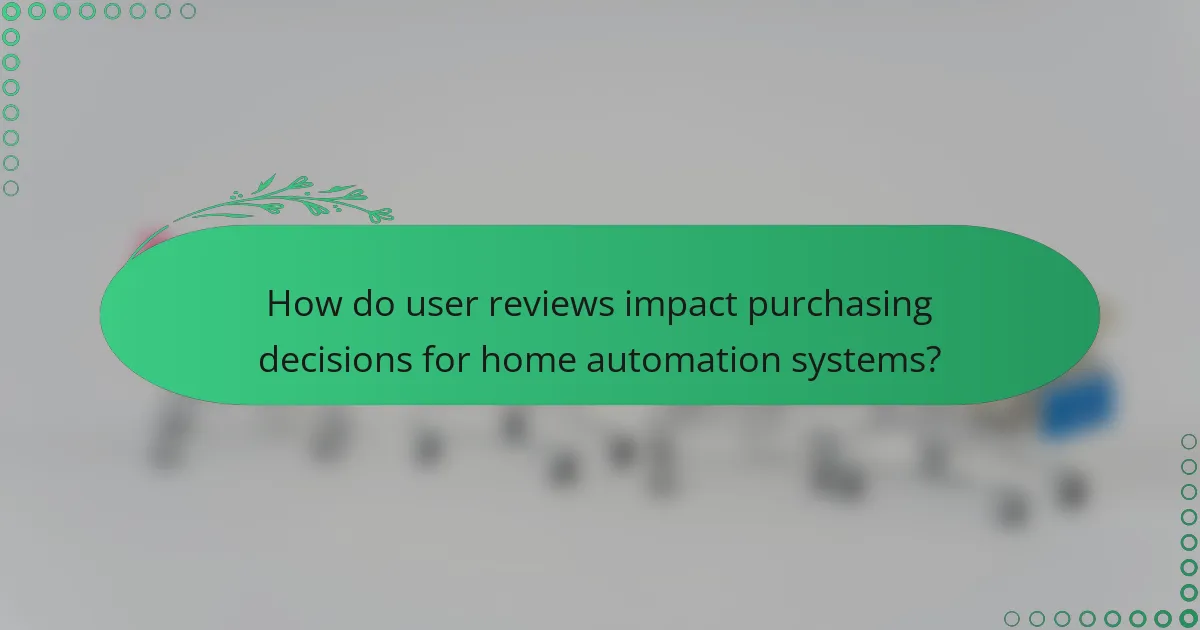
How do user reviews impact purchasing decisions for home automation systems?
User reviews significantly influence purchasing decisions for home automation systems by providing potential buyers with insights into real-world performance and user satisfaction. These reviews help consumers gauge the effectiveness and reliability of various systems, ultimately shaping their choices.
Influence on brand perception
User reviews play a crucial role in shaping brand perception for home automation systems. Positive feedback can enhance a brand’s image, making it appear more trustworthy and reliable. Conversely, negative reviews can tarnish a brand’s reputation, leading consumers to avoid certain products.
For example, a brand with a high volume of positive reviews may be perceived as a leader in innovation and quality, while one with frequent complaints about security issues may be viewed as less dependable. This perception can directly affect sales and market share.
Impact on trust and credibility
User reviews contribute to building trust and credibility for home automation systems. When potential buyers see authentic feedback from existing users, they are more likely to feel confident in their purchasing decisions. Reviews that highlight security performance, in particular, can reassure customers about the safety of their homes.
To enhance trust, look for reviews that mention specific experiences with security features, such as alarm responsiveness or ease of use. Brands that actively engage with reviewers, addressing concerns and thanking users for positive feedback, can further bolster their credibility.
Role in comparing features
User reviews serve as a valuable resource for comparing features of different home automation systems. They often highlight practical aspects that specifications alone may not convey, such as ease of installation, user interface, and customer support experiences.
When evaluating systems, consider creating a comparison chart based on user feedback. Focus on key features like security protocols, integration with other devices, and user satisfaction ratings. This approach can help streamline your decision-making process and ensure you choose a system that meets your specific needs.
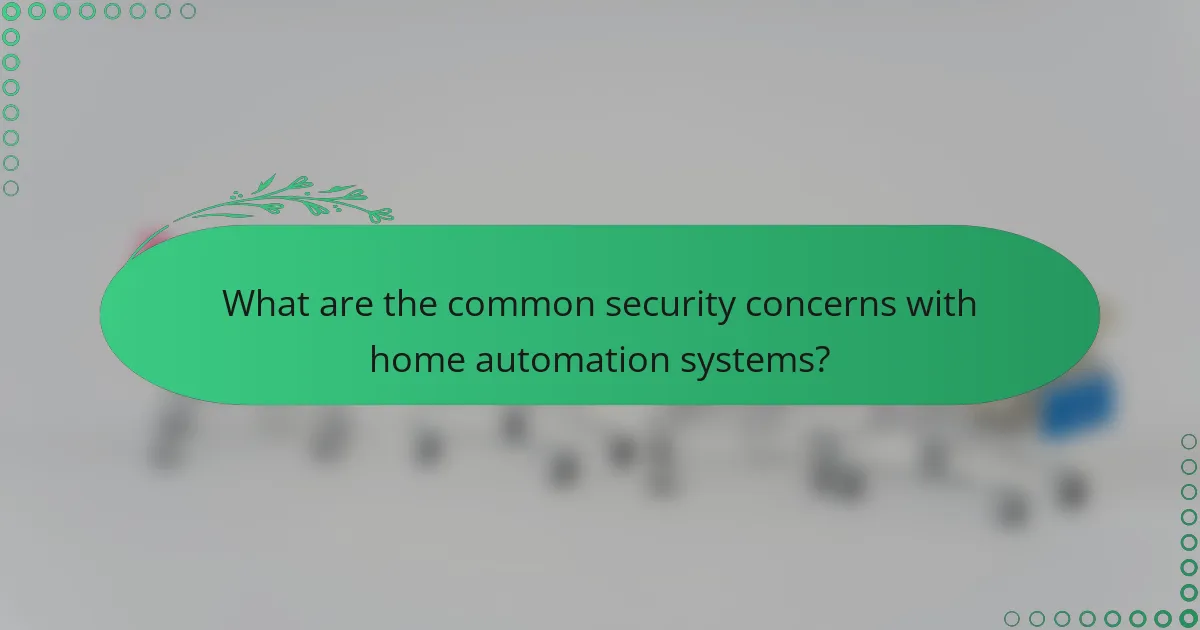
What are the common security concerns with home automation systems?
Home automation systems raise several security concerns that users should be aware of, including data privacy issues, vulnerability to hacking, and reliability of internet connections. Understanding these risks can help users make informed decisions about their home automation setups.
Data privacy issues
Data privacy is a significant concern with home automation systems, as these devices often collect and transmit personal information. Users should be cautious about what data is being shared and stored by the devices, as unauthorized access can lead to privacy breaches.
To mitigate these risks, consider using devices that offer strong encryption and clear privacy policies. Regularly reviewing privacy settings and opting out of unnecessary data sharing can also enhance your security.
Vulnerability to hacking
Home automation systems can be vulnerable to hacking if not properly secured. Cybercriminals may exploit weak passwords, outdated software, or unsecured networks to gain access to your devices and personal information.
To protect against hacking, always use strong, unique passwords for each device and enable two-factor authentication where available. Keeping software updated and using a secure Wi-Fi network can further reduce the risk of unauthorized access.
Reliability of internet connection
The reliability of your internet connection is crucial for the effective functioning of home automation systems. A weak or unstable connection can lead to system failures, making devices unresponsive or inaccessible when needed.
To ensure a reliable connection, consider investing in a robust router and placing it in a central location. Regularly testing your internet speed and upgrading your plan if necessary can help maintain consistent performance for your home automation setup.
